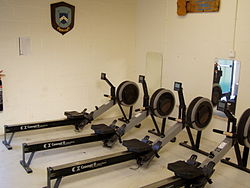Indoor rower: Difference between revisions
No edit summary |
|||
| Line 20: | Line 20: | ||
==External links== |
==External links== |
||
* [http://www.indoor-rowing.blogspot.com Indoor Rowing Blog by Xeno Muller Olympic Gold and Silver Medal Winner] |
* [http://www.indoor-rowing.blogspot.com Indoor Rowing Blog by Xeno Muller Olympic Gold and Silver Medal Winner] |
||
*[http://www.rowbike.com Rowbike Total Body Fitness Machine] |
|||
[[Category:Exercise equipment]] |
[[Category:Exercise equipment]] |
||
[[Category:Rowing]] |
[[Category:Rowing]] |
||
Revision as of 23:34, 9 February 2006

An indoor rower is a machine used to simulate the action of watercraft rowing for the purpose of exercise or training for rowing. Indoor Rowing has become established as a sport in its own right. The term also refers to a participant in this sport.
An indoor rower is also known as an ergometer (slang ergo or erg). An ergometer being a device which measures the amount of energy or work performed. The indoor rower is calibrated to measure the amount of energy the rower is generating. Ergometer comes from the Greek word's ergon, meaning work and metron, meaning measure. An ergometer therefore is a device that literally means "work measurer".
Layout of the machine
Although several simple machines exist for casual home use, there are three major models: RowPerfect, WaterRower and Concept2. Of these the Concept2 is the most popular, and is generally considered the standard training option for world-class rowers. Each machine consists of a flywheel connected to a chain and handle. The rower pushes his body backwards with the legs and pulls on the handle, causing the flywheel to spin. The flywheel has a damping mechanism applied (using either air or water) that is intended to simulate the feel of an oar moving through water. Depending on the machine the rower either moves back and forth as part of the rowing action, or the rower remains stationary and the flywheel mechanism moves. The machines where the rower remains stationary are generally considered to better simulate the feel of a boat.
Each machine features a digital performance monitor that can display the athlete's work output in watts, calories, or notional "meters" that are roughly calibrated to correspond to the speed of a four-man boat on the water. The standard measurement of speed on an ergometer is generally known as the "split," or the amount of time in minutes and seconds required to travel 500 meters at the current pace. For example, a 2:00 split would correspond to a 2:00 time for a 500 meter race, or an 8:00 time for a 2 kilometer race. The split does not necessarily correspond to how many strokes the rower takes (the "rating") since strokes can vary in power.
Competitions
Concept2 organizes a large number of indoor rowing competitions all over the world, including the world championships (a.k.a. CRASH-B Sprints) held in Boston, Massachusetts, USA in February and the British Indoor Rowing Championships held in Birmingham, England in November. The usual distance for competition is 2,000 m. The machines used are very consistent and although the resistance may be adjusted, a result on one machine can be fairly compared with results on other machines regardless of resistance level. The prevalence of Concept2 machines creates a standard which facilitates competition.
Indoor rowing is an inclusive sport, perhaps because indoor rowing has historically been used for fitness, training and self-improvement rather than as an independent form of competition. Despite increasing competitiveness in recent years, most major competitions include many categories based on age as well as weight. While the fastest times are generally achieved by rowers between 20 and 40 years old, teenagers and rowers over 90 are common at competitions. Inexperienced rowers as well as world class athletes are welcome.
The world records for 2,000 m are currently (as of December 2005) 5:37.0 for men and 6:28.4 for women. Full Records For All Distances
